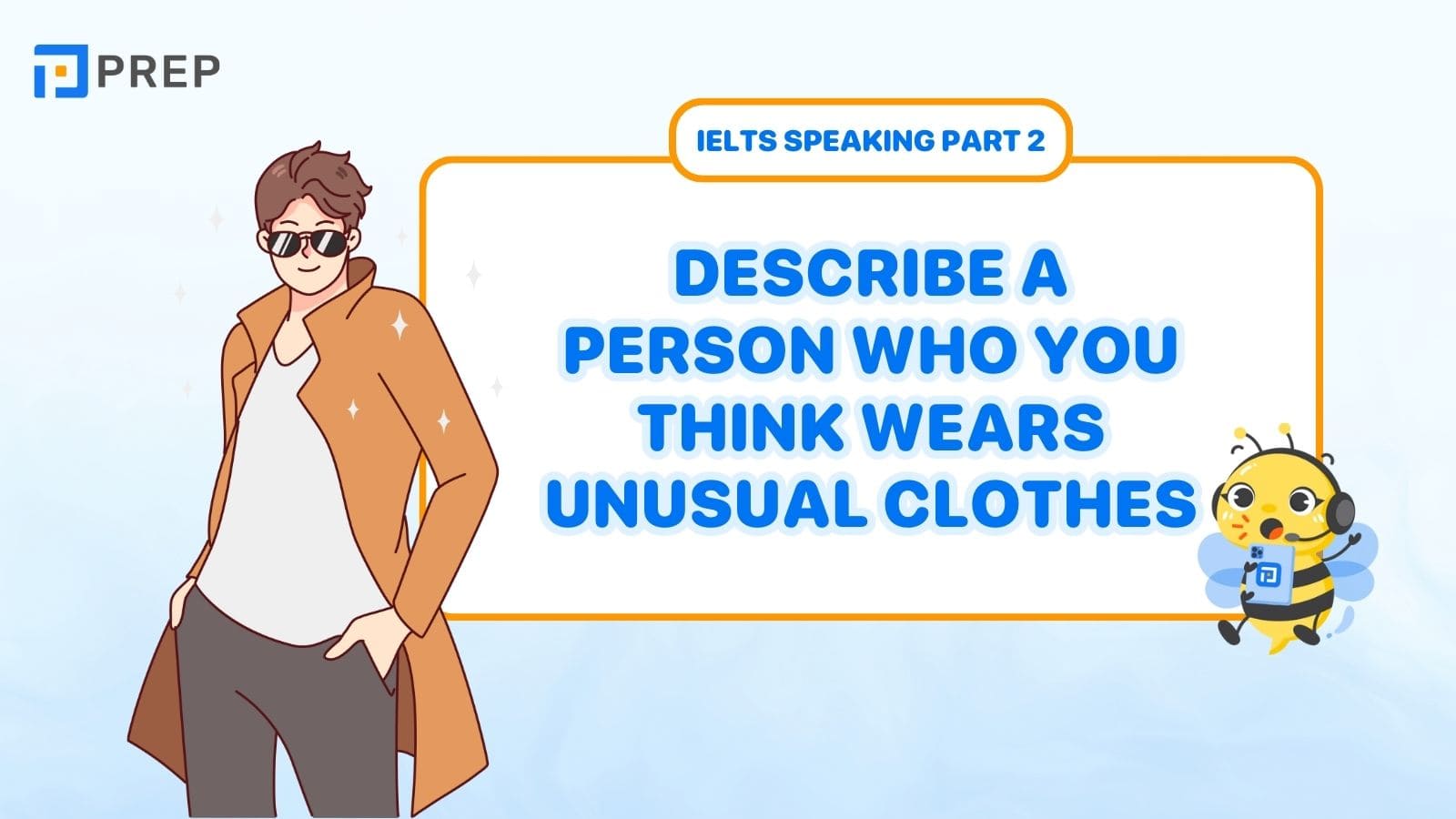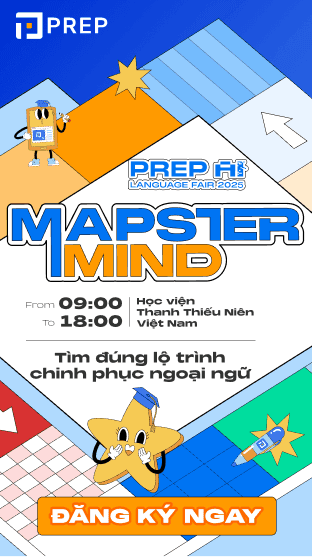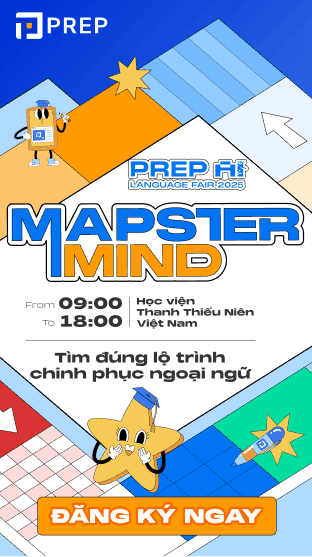Bài mẫu Speaking Part 2, 3: Describe a person who you think wears unusual clothes
Describe a person who you think wears unusual clothes - đề bài IELTS Speaking không quá “hóc búa” nếu như thí sinh vạch ra được ý tưởng, dàn bài rõ ràng, chi tiết. Trình bày bài nói mạch lạc và sử dụng những từ vựng ăn điểm theo chủ đề là một điểm cộng để bạn nhanh chóng nâng band điểm Speaking. Hãy cùng tham khảo cách xử lý đề bài Describe a person who you think wears unusual clothes của thầy cô giáo tại PREP trong bài viết dưới đây bạn nhé!
[caption id="attachment_26432" align="aligncenter" width="501"] Bài mẫu Speaking Part 2, 3: Describe a person who you think wears unusual clothes[/caption]
Bài mẫu Speaking Part 2, 3: Describe a person who you think wears unusual clothes[/caption]
I. Bài mẫu IELTS Speaking Part 2 chủ đề Describe a person who you think wears unusual clothes
1. Đề bài: Describe a person who you think wears unusual clothes
Describe a person who wears unusual clothes/ Describe a person who you think wears unusual clothes. You should say:
- Who is he/she?
- How do you know him/her?
- What kind of clothes he/she wears?
Why do you consider that his/her clothing choices are weird?
[caption id="attachment_26434" align="aligncenter" width="1640"] Đề bài: Describe a person who you think wears unusual clothes[/caption]
Đề bài: Describe a person who you think wears unusual clothes[/caption]
2. Dàn bài Part 2
2.1. Ý tưởng bài mẫu (tiếng Việt)
| Là ai | Quen biết bằng cách nào |
| Mary Ann |
Từng học cùng đại học Chỉ thi thoảng gặp nhau trên hành lang và trong bãi đỗ xe |
| Loại quần áo người đó mặc | Tại sao nó lại kỳ lạ |
|
Quần áo theo phong cách Lolita Trang nhã và trưởng thành Dáng thuôn, váy dài quá đầu gối, màu trơn, họa tiết hoa thủy tiên và vương miện. |
Phong cách không phổ biến ở Việt Nam Chỉ là cách thể hiện sở thích vô hại và tạo ấn tượng mạnh mẽ với mọi người xung quanh. |
2.2. Take-note trong 1 phút (tiếng Anh)
| Who | How you know about her |
| Mary Ann |
|
| What she wears | Why it’s weird |
|
|
3. Sample Speaking: Describe a person who you think wears unusual clothes
Bài mẫu Describe a person who you think wears unusual clothes IELTS Speaking Part 2 được biên soạn bởi thầy cô giáo tại prepedu.com. Tham khảo bài nói Describe a person who you think wears unusual clothes để ôn luyện thi Speaking hiệu quả tại nhà bạn nhé!
I’ve always been fashion conscious since young, so people who are dressed bizarrely usually catch my eyes. The person that immediately pops up in my head when I see this question is Mary Ann, a girl I only knew by nickname in college.
To get the facts straight, Mary Ann and I are definitely not friends nor even acquaintances. She and I shared only one class back in 4 years of university, and besides the rare encounters in the hallways or parking lots, we hardly ever crossed paths. But Mary Ann had always been such a prominent name in my school that even the clueless me heard about her way before we met. This was mostly due to the down to Earth yet confident way that she carried herself and the particularly eye-catching fashion style that she followed.
Mary Ann was partial to Lolita fashion, a subculture originated from Japan, which is heavily influenced by Victorian and Rococo periods’ aesthetics, and always without fail came to class in clothes of this style. Instead of the emphasis on cuteness that people usually assume when it comes to Lolita, Mary Ann’s clothes radiate a sense of elegance and maturity, with streamlined silhouettes, tea length skirts, solid color pieces along with prints featuring motifs like crowns or fleur de lis.
Needless to say, she stood out no matter where she went and what she did, because how many people do you see in real life choose Lolita as daily fashion items, to school no less?
Mary Ann’s clothes are definitely one of a kind in a country like Vietnam, where Lolita is not popular outside of the cosplay community. Many people I know criticize her for not projecting a, in their words, “appropriate” enough image in the university. While I did not know Mary Ann personally, in the few times I caught sight of her, she was always smiling gracefully and had the most content aura around her.
None of her clothes were revealing or scruffy, and she most likely dressed to satisfy a harmless interest, while at the same time managing to create a strong, long-lasting impression for herself. In short, if what she wore was weird, it was truly the best kind of weird.
Một số từ vựng ăn điểm được sử dụng trong bài mẫu Describe a person who you think wears unusual clothes IELTS Speaking Part 2:
- fashion conscious (a): quan tâm đến thời trang
- catch one’s eyes (phr): thu hút ánh mắt của ai, khiến ai chú ý
- pop up in one’s head (phr): hiện ra trong suy nghĩ ai đó
- to get the facts straight (phr): nói rõ ràng, nói cho đúng thì
- acquaintance (n): người quen
- encounter (n): lần gặp gỡ, bắt gặp
- cross paths (phr): tình cờ gặp ai
- prominent (a): nổi bật
- down to Earth (a): bình dị, gần gũi
- the way somebody carries oneself (phr): ngôn ngữ cơ thể, cử chỉ, tư thế của ai đó
- eye-catching (a): bắt mắt
- to be partial to (a): đặc biệt thích cái gì
- subculture (n): tiểu văn hóa
- aesthetics (n): mỹ học, thẩm mỹ
- emphasis (n): sự tập trung
- radiate (v): tỏa ra
- elegance (n): sự thanh lịch, tao nhã
- maturity (n): sự trưởng thành
- streamline (a): dáng thuôn
- silhouettes (n): phom dáng
- tea length skirts (n): váy dài dưới đầu gối và trên mắt cá
- solid color (n): màu đơn
- motifs (n): họa tiết
- fleur de lis (n): hoa thủy tiên cách điệu
- Needless to say (phr): khỏi phải nói, tất nhiên là
- one of a kind (a): đặc biệt, độc nhất vô nhị
- project an image (v): thể hiện một hình ảnh
- catch sight of (phr): nhìn thấy, bắt gặp
- content (a): thỏa mãn, hài lòng
- aura (n): hào quang
- revealing (a): hở hang
- scruffy (a): lôi thôi, bẩn thỉu
Tham khảo thêm Bài mẫu IELTS Speaking Part 2, 3: Describe an occasion you wore the best clothes
II. Câu trả lời mẫu IELTS Speaking Part 3: Shopping
Shopping - chủ đề tiếp theo được giám khảo chọn lựa để kiểm tra khả năng nói của thí sinh sau bài thi Describe a person who you think wears unusual clothes IELTS Speaking Part 2. Cùng xem thầy cô giáo tại prepedu.com xử lý những câu hỏi Part 3 này như thế nào nhé!
[caption id="attachment_26435" align="aligncenter" width="1640"] Câu trả lời mẫu IELTS Speaking Part 3: Shopping[/caption]
Câu trả lời mẫu IELTS Speaking Part 3: Shopping[/caption]
1. Where do Vietnamese people normally buy clothes?
Well, the answer would vary depending on who you are asking. If, say, you belong to the average income family groups, you may buy clothes in street markets’ stalls, where it’s relatively easier to get a good deal. Bargaining is also common in small stores here in Vietnam, so these are places that people who want more affordable clothes might drop by.
However, if one’s searching for more high-end, luxurious brands, they might be loyal customers of megamalls where stores of Louis Vuitton, Balenciaga are usually located. And last but not least, online shopping, which has had a growth boom in the last decade, proves to become more of a norm when it comes to clothes purchasing too.
- relatively (adv): tương đối
- get a good deal (phr): được món hời
- bargain (v): mặc cả
- high-end (a): thuộc phân khúc cao cấp
- mega mall (n): đại siêu thị
- become a norm (phr): trở thành một điều quen thuộc, phổ biến
2. The difference between men’s and women’s choices of clothes?
It’s often believed that men prioritize comfort and tend to be more laid-back with what they wear, whereas women care more about clothes and may prefer being dressed-up. For me, this is merely a myth that is correct with some, yet totally amiss with others. Personally, I am someone who believes clothes are not gender-coded, so quite frankly the idea of males and females being complete opposites when it comes to clothes and cannot share any similarities kinda irks me.
- prioritize (v): ưu tiên
- laid-back (a): thoải mái
- dressed-up (a): ăn mặc diện
- myth (n): truyền thuyết
- amiss (a): sai lệch
- frankly (adv): thẳng thắn mà nói
- irk (v): làm ai khó chịu
3. Do clothes affect people’s mood?
Oh, I believe they do, though the extent would vary. Fashion items are of a myriad of colors, textures, patterns and styles, all of which have an influence on our mood, albeit subconsciously. I for sure would feel quite annoyed having to wear a color I hate, or become a bit down if the patterns on my sweater creeps me out. Some pieces of clothing represent cultural customs and religious beliefs, so they could change how you feel too. Being in traditional clothes can evoke patriotism in certain situations, for example.
- extent (n): mức độ
- a myriad of (phr): nhiều
- texture (n): chất liệu
- pattern (n): họa tiết
- albeit (adv): mặc dù
- subconsciously (adv): trong tiềm thức
- creep somebody out (phr): khiến ai đó sợ, không thoải mái
- evoke (v): khơi gợi
- patriotism (n): tình yêu nước
III. Lời Kết
Trên đây là bài mẫu Describe a person who you think wears unusual clothes IELTS Speaking Part 2, 3 đầy đủ nhất. Chúc bạn ôn thi IELTS hiệu quả và chinh phục được band điểm 7.5+ Speaking trong kỳ thi thực chiến sắp tới nhé!

Chào bạn! Mình là Hiền Hoàng, hiện đang đảm nhận vai trò quản trị nội dung sản phẩm tại Blog của website prepedu.com.
Với hơn 5 năm tự học các ngoại ngữ như tiếng Anh, tiếng Trung và ôn luyện một số kỳ thi IELTS, TOEIC, HSK, mình đã tự đúc rút được nhiều kinh nghiệm để hỗ trợ hàng nghìn người đang gặp khó khăn trong việc học ngoại ngữ. Hy vọng rằng những chia sẻ phía trên sẽ giúp ích cho bạn trong quá trình tự ôn luyện thi hiệu quả tại nhà!
Bình luận
Nội dung premium
Xem tất cảLộ trình cá nhân hoá
Có thể bạn quan tâm
Kết nối với Prep

MSDN: 0109817671.
Địa chỉ liên hệ: Tòa nhà Vinaconex, 34 Láng Hạ, phường Láng, TP Hà Nội.
Trung tâm CSKH tại HN: Lô 21 C2 Khu đô thị Nam Trung Yên, phường Yên Hòa, TP Hà Nội.
Trung tâm CSKH tại HCM: 288 Pasteur, Phường Xuân Hòa, TP Hồ Chí Minh
Trụ sở Công ty: Số nhà 20, ngách 234/35 đường Hoàng Quốc Việt, phường Nghĩa Đô, TP Hà Nội.
Phòng luyện ảo - Trải nghiệm thực tế - Công nghệ hàng đầu.
Hotline: 0931 42 8899.
Trụ sở Công ty: Số nhà 20, ngách 234/35 đường Hoàng Quốc Việt, phường Nghĩa Đô, TP Hà Nội.
Giấy chứng nhận hoạt động đào tạo, bồi dưỡng số 1309/QĐ-SGDĐT ngày 31 tháng 07 năm 2023 do Sở Giáo dục và Đào tạo Hà Nội cấp.

























